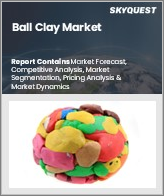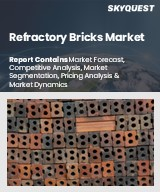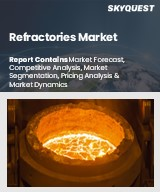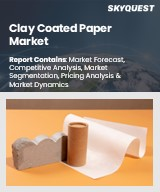
|
시장보고서
상품코드
1734459
세계의 볼 클레이 시장 규모, 점유율, 성장 분석, 형태별, 가격별, 용도별, 지역별 - 산업 예측(2025-2032년)Ball Clay Market Size, Share, and Growth Analysis, By Form (Stone, Powder), By Prices (Below $40, $40 - $50), By Application (Ceramic, Non-Ceramic), By Region - Industry Forecast 2025-2032 |
||||||
볼 클레이 세계 시장 규모는 2023년 4억 5,020만 달러, 2024년 4억 7,406만 달러에서 2032년에는 7억 1,657만 달러로 성장하고, 예측 기간(2025-2032년)의 CAGR은 5.3%를 나타낼 전망입니다.
볼 클레이 세계 시장은 건설, 자동차, 소비재 등의 분야에 필수적인 세라믹 수요 증가에 의해 크게 견인되고 있습니다. 볼 클레이의 높은 가소성, 미세한 입자 크기, 우수한 성형성은 타일, 위생 도자기 등의 제품에 이상적입니다. 특히 신흥국 시장의 도시화가 가속화됨에 따라 세라믹 소비가 급증하여 볼 클레이 수요와 시장 성장을 가속하고 있습니다. 동시에 각국 정부가 생태계에 대한 피해를 줄이기 위해 엄격한 채굴 기준을 설정함에 따라 환경 규제가 업계에 영향을 미치고 있습니다. 이러한 규제를 준수하기 위해서는 고도의 기술이 필요한 경우가 많기 때문에 운영 비용이 상승하고, 채굴장이 제한되어 공급이 제한될 수 있습니다. 결과적으로 이러한 요인들이 가격 상승을 유발하고, 환경 정책이 엄격한 지역에서 볼 클레이의 가용성에 영향을 미칠 수 있으며, 수요와 규제 문제가 복잡하게 얽혀 있다는 점을 강조합니다.
목차
서론
- 조사 목적
- 조사 범위
- 정의
조사 방법
- 정보 조달
- 2차와 1차 데이터 방법
- 시장 규모 예측
- 시장 전제조건과 제한
주요 요약
- 세계 시장 전망
- 공급과 수요 동향 분석
- 부문별 기회 분석
시장 역학과 전망
- 시장 개요
- 시장 규모
- 시장 역학
- 성장 촉진요인과 기회
- 성장 억제요인과 과제
- Porter의 Five Forces 분석
주요 시장 인사이트
- 중요 성공 요인
- 경쟁 정도
- 주요 투자 기회
- 시장 생태계
- 시장의 매력 지수(2024년)
- PESTEL 분석
- 거시경제 지표
- 밸류체인 분석
- 가격 분석
- 사례 연구
- 고객 구매 행동 분석
볼 클레이 시장 규모 : 형태별&CAGR(2025-2032)
- 시장 개요
- 스톤
- 파우더
- 파쇄
- 기타
볼 클레이 시장 규모 : 가격별&CAGR(2025-2032)
- 시장 개요
- 40달러 이하
- 40달러-50 달러
- 50달러 이상
볼 클레이 시장 규모 : 용도별&CAGR(2025-2032)
- 시장 개요
- 세라믹
- 위생도기
- 식기
- 벽 및 바닥 타일
- 건축자재
- 전기 자기
- 절연체
- 기타
- 비세라믹
- 접착제 및 실란트
- 비료 및 살충제
- 플라스틱
- 기타
볼 클레이 시장 규모 : 지역별&CAGR(2025-2032)
- 북미
- 미국
- 캐나다
- 유럽
- 독일
- 스페인
- 프랑스
- 영국
- 이탈리아
- 기타 유럽
- 아시아태평양
- 중국
- 인도
- 일본
- 한국
- 기타 아시아태평양
- 라틴아메리카
- 브라질
- 기타 라틴아메리카
- 중동 및 아프리카
- GCC 국가
- 남아프리카공화국
- 기타 중동 및 아프리카
경쟁 정보
- 주요 5개사 비교
- 주요 기업의 시장 포지셔닝(2024년)
- 주요 시장 기업이 채택한 전략
- 최근 시장 동향
- 기업의 시장 점유율 분석(2024년)
- 주요 기업 개요
- 기업 상세
- 제품 포트폴리오 분석
- 기업 부문별 점유율 분석
- 매출 전년대비 비교(2022-2024년)
주요 기업 개요
- Ashapura Group
- Burgess Pigment Company
- EICL Limited
- G&W Minerals Resources
- Glocha Associated
- Gujarat Minerals Development Corporation Ltd.
- I-Minerals Inc.
- Kamin LLC
- LKAB Minerals
- Old Hickory Clay Company
- Quarzwerke Group
- Sibelco
결론과 제안
LSH 25.06.11Global Ball Clay Market size was valued at USD 450.2 million in 2023 and is poised to grow from USD 474.06 million in 2024 to USD 716.57 million by 2032, growing at a CAGR of 5.3% during the forecast period (2025-2032).
The global ball clay market is significantly driven by rising demand for ceramics, essential for sectors like construction, automotive, and consumer goods. Ball clay's high plasticity, fine particle size, and excellent moldability make it ideal for products such as tiles and sanitaryware. As urbanization accelerates, particularly in developing regions, ceramic consumption surges, boosting ball clay demand and market growth. Concurrently, environmental regulations impact the industry as governments enforce stringent mining standards to mitigate ecological harm. This compliance often necessitates advanced technologies, elevating operational costs and potentially limiting mining sites, leading to supply constraints. Consequently, these factors can trigger price increases and affect ball clay availability in regions with strict environmental policies, highlighting a complex interplay between demand and regulatory challenges.
Top-down and bottom-up approaches were used to estimate and validate the size of the Global Ball Clay market and to estimate the size of various other dependent submarkets. The research methodology used to estimate the market size includes the following details: The key players in the market were identified through secondary research, and their market shares in the respective regions were determined through primary and secondary research. This entire procedure includes the study of the annual and financial reports of the top market players and extensive interviews for key insights from industry leaders such as CEOs, VPs, directors, and marketing executives. All percentage shares split, and breakdowns were determined using secondary sources and verified through Primary sources. All possible parameters that affect the markets covered in this research study have been accounted for, viewed in extensive detail, verified through primary research, and analyzed to get the final quantitative and qualitative data.
Global Ball Clay Market Segments Analysis
Global Ball Clay Market is segmented by Form, Prices, Application and region. Based on Form, the market is segmented into Stone, Powder, Shredded and Others. Based on Prices, the market is segmented into Below $40, $40 - $50 and Above $50. Based on Application, the market is segmented into Ceramic and Non-Ceramic. Based on region, the market is segmented into North America, Europe, Asia Pacific, Latin America and Middle East & Africa.
Driver of the Global Ball Clay Market
The increasing demand for ceramics across several sectors, including construction, automotive, and consumer products, significantly fuels the expansion of the global ball clay market. As industries recognize the necessity for high-quality raw materials like ball clay in producing tiles, sanitaryware, and pottery, they are increasingly relying on this material. This trend not only highlights the essential role of ball clay in achieving desirable ceramic properties but also underscores its growing importance in various manufacturing processes, further driving market growth and enhancing the overall market landscape for ball clay.
Restraints in the Global Ball Clay Market
The Global Ball Clay market faces certain challenges due to the restricted availability of high-quality ball clay in specific regions, which could hinder overall market expansion. As the demand for premium ball clay continues to grow, particularly in the ceramics industry and other applications, areas with insufficient natural deposits may struggle to meet this demand, leading to supply shortages. Such limitations can result in increased costs and potential disruptions in production timelines, ultimately impeding the growth opportunities within the market. Consequently, addressing these supply constraints is crucial for sustaining the momentum of the Global Ball Clay market.
Market Trends of the Global Ball Clay Market
The Global Ball Clay market is witnessing a robust growth trend, primarily driven by the escalating demand from the ceramics industry. Ball clay's exceptional properties, including fine particle size, high plasticity, and remarkable strength, make it indispensable in the production of tiles, sanitaryware, and porcelain articles. This demand is particularly pronounced in the Asia-Pacific region, where rapid urbanization and infrastructure development are fueling extensive construction activities. As housing projects proliferate, the ceramics market is expanding, further solidifying ball clay's vital role in the manufacturing sector. Consequently, this trend underscores the increasing significance of ball clay in the global materials marketplace.
Table of Contents
Introduction
- Objectives of the Study
- Scope of the Report
- Definitions
Research Methodology
- Information Procurement
- Secondary & Primary Data Methods
- Market Size Estimation
- Market Assumptions & Limitations
Executive Summary
- Global Market Outlook
- Supply & Demand Trend Analysis
- Segmental Opportunity Analysis
Market Dynamics & Outlook
- Market Overview
- Market Size
- Market Dynamics
- Drivers & Opportunities
- Restraints & Challenges
- Porters Analysis
- Competitive rivalry
- Threat of substitute
- Bargaining power of buyers
- Threat of new entrants
- Bargaining power of suppliers
Key Market Insights
- Key Success Factors
- Degree of Competition
- Top Investment Pockets
- Market Ecosystem
- Market Attractiveness Index, 2024
- PESTEL Analysis
- Macro-Economic Indicators
- Value Chain Analysis
- Pricing Analysis
- Case Studies
- Customer Buying Behavior Analysis
Global Ball Clay Market Size by Form & CAGR (2025-2032)
- Market Overview
- Stone
- Powder
- Shredded
- Others
Global Ball Clay Market Size by Prices & CAGR (2025-2032)
- Market Overview
- Below $40
- $40 - $50
- Above $50
Global Ball Clay Market Size by Application & CAGR (2025-2032)
- Market Overview
- Ceramic
- Sanitary ware
- Tableware
- Wall & floor tiles
- Building material
- Electrical porcelain
- Insulators
- Others
- Non-Ceramic
- Adhesive & sealants
- Fertilizers & insecticides
- Plastics
- Others
Global Ball Clay Market Size & CAGR (2025-2032)
- North America (Form, Prices, Application)
- US
- Canada
- Europe (Form, Prices, Application)
- Germany
- Spain
- France
- UK
- Italy
- Rest of Europe
- Asia Pacific (Form, Prices, Application)
- China
- India
- Japan
- South Korea
- Rest of Asia-Pacific
- Latin America (Form, Prices, Application)
- Brazil
- Rest of Latin America
- Middle East & Africa (Form, Prices, Application)
- GCC Countries
- South Africa
- Rest of Middle East & Africa
Competitive Intelligence
- Top 5 Player Comparison
- Market Positioning of Key Players, 2024
- Strategies Adopted by Key Market Players
- Recent Developments in the Market
- Company Market Share Analysis, 2024
- Company Profiles of All Key Players
- Company Details
- Product Portfolio Analysis
- Company's Segmental Share Analysis
- Revenue Y-O-Y Comparison (2022-2024)
Key Company Profiles
- Ashapura Group
- Company Overview
- Business Segment Overview
- Financial Updates
- Key Developments
- Burgess Pigment Company
- Company Overview
- Business Segment Overview
- Financial Updates
- Key Developments
- EICL Limited
- Company Overview
- Business Segment Overview
- Financial Updates
- Key Developments
- G&W Minerals Resources
- Company Overview
- Business Segment Overview
- Financial Updates
- Key Developments
- Glocha Associated
- Company Overview
- Business Segment Overview
- Financial Updates
- Key Developments
- Gujarat Minerals Development Corporation Ltd.
- Company Overview
- Business Segment Overview
- Financial Updates
- Key Developments
- I-Minerals Inc.
- Company Overview
- Business Segment Overview
- Financial Updates
- Key Developments
- Kamin LLC
- Company Overview
- Business Segment Overview
- Financial Updates
- Key Developments
- LKAB Minerals
- Company Overview
- Business Segment Overview
- Financial Updates
- Key Developments
- Old Hickory Clay Company
- Company Overview
- Business Segment Overview
- Financial Updates
- Key Developments
- Quarzwerke Group
- Company Overview
- Business Segment Overview
- Financial Updates
- Key Developments
- Sibelco
- Company Overview
- Business Segment Overview
- Financial Updates
- Key Developments



















